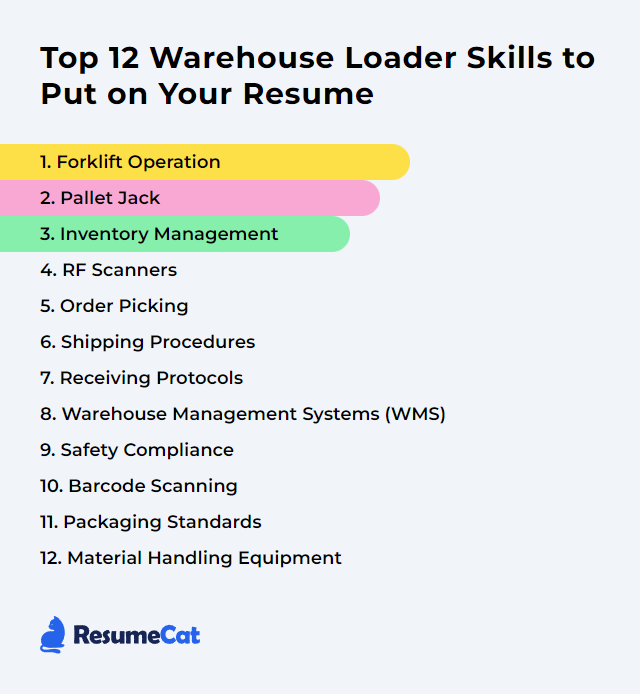Top 12 Warehouse Loader Skills to Put on Your Resume
In today’s tight labor market, a warehouse loader’s resume has to stand out. The right skills, framed clearly, do the heavy lifting. Below, twelve essentials—what they are, why they matter, and how to sharpen them—so you can show impact fast and land interviews.
Warehouse Loader Skills
- Forklift Operation
- Pallet Jack
- Inventory Management
- RF Scanners
- Order Picking
- Shipping Procedures
- Receiving Protocols
- Warehouse Management Systems (WMS)
- Safety Compliance
- Barcode Scanning
- Packaging Standards
- Material Handling Equipment
1. Forklift Operation
Forklift operation means maneuvering a powered industrial truck to move, lift, and stack materials, supporting fast, accurate loading and unloading.
Why It's Important
Forklifts multiply a loader’s reach—safer lifts, faster turns, less strain. Done right, they boost throughput and cut injuries.
How to Improve Forklift Operation Skills
Focus on safety, control, and flow.
Training and Certification: Complete and maintain OSHA-compliant PIT training with periodic refreshers and check rides.
Pre-Shift Checks: Inspect forks, mast, hydraulics, brakes, horn, lights, and tires before every shift. Tag out anything suspect.
Maintenance Rhythm: Stick to a preventive schedule—fluids, filters, hydraulics, batteries/chargers—so downtime doesn’t ambush you.
Safety Add‑ons: Use blue/red safety lights, mirrors, backup alarms, speed governors, and clear pedestrian lanes with floor markings.
Smart Layout: Widen turns, separate foot traffic, remove blind spots, set one‑way aisles where feasible.
Telematics: Track impacts, pre‑trip compliance, speed, and utilization to coach and correct.
Communication: Hand signals, radios, and standardized right‑of‑way rules. No guesswork on a busy dock.
Train well, maintain well, and the machine will repay you in smooth, steady productivity.
How to Display Forklift Operation Skills on Your Resume
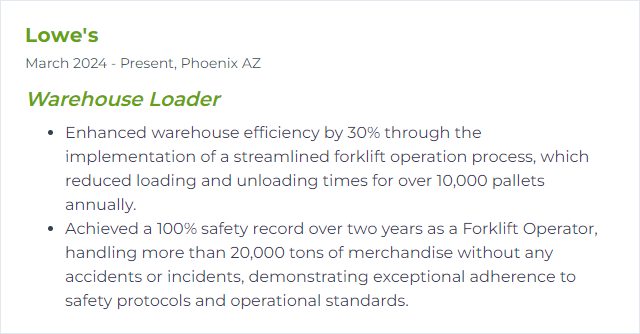
2. Pallet Jack
A pallet jack—manual or powered—lifts and moves pallets quickly across short warehouse runs.
Why It's Important
It’s the nimble mover: less effort for heavy loads, faster turns in tight spaces, fewer strains.
How to Improve Pallet Jack Skills
Ergonomics: Choose models with comfortable grips, responsive controls, and low start‑up force to cut fatigue.
Maintenance: Grease wheels, check forks, verify hydraulics, keep batteries charged and watered (for powered units).
Right Capacity: Match load ratings to your heaviest daily moves—no overloading, no drag.
Operator Training: Safe slopes, proper turning, correct load placement, and clear line‑of‑sight pulling.
Tech Touches: Consider scales, load indicators, or geofencing on electric jacks for better control and accountability.
How to Display Pallet Jack Skills on Your Resume

3. Inventory Management
Inventory management controls how goods are received, stored, moved, and counted so the right items are ready at the right time.
Why It's Important
It prevents stockouts and overstock, speeds orders, and keeps space and cash from getting trapped in the wrong places.
How to Improve Inventory Management Skills
Use a System: Record every move in a WMS or robust tracking tool. No side piles, no mystery pallets.
Cycle Counts: Run routine cycle counts with ABC priority. Find drift early and fix roots, not just numbers.
Clear Organization: Logical slotting, clean labels, visible locations, FIFO/FEFO for date‑sensitive goods.
Training + Comms: Align loaders, receivers, and pickers on the same rules—scan in, scan out, every time.
Forecast Feedback: Share fast‑movers and slow‑movers with planners so stocking follows reality.
How to Display Inventory Management Skills on Your Resume
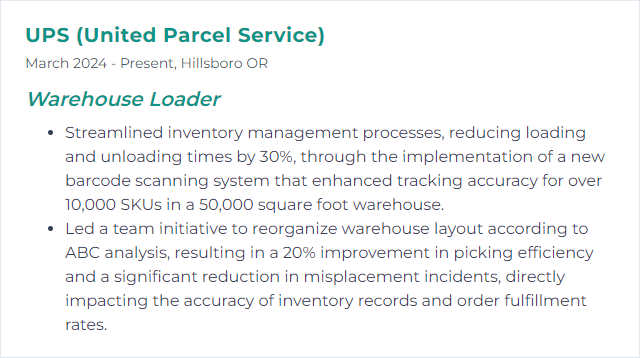
4. RF Scanners
RF scanners are handhelds that read barcodes or RFID, sending data over the network to keep inventory records live and accurate.
Why It's Important
They slash errors, speed confirmations, and make every move traceable. Fewer mispicks. Fewer headaches.
How to Improve RF Scanners Skills
Ergonomics: Light devices, easy triggers, glove‑friendly screens. Less fatigue, more speed.
Power: Long batteries, hot‑swap packs, fast chargers, and a charging routine that sticks.
Connectivity: Strong Wi‑Fi (6/6E—and 7 where available), roaming tuned to avoid dead zones, and offline queueing if a drop happens.
Durability: Rugged shells, IP‑rated seals, and bumpers for drops, dust, and moisture.
Advanced Imaging: 1D/2D reads at angles, distance scanning, and reliable reads on wrinkled or damaged labels.
How to Display RF Scanners Skills on Your Resume
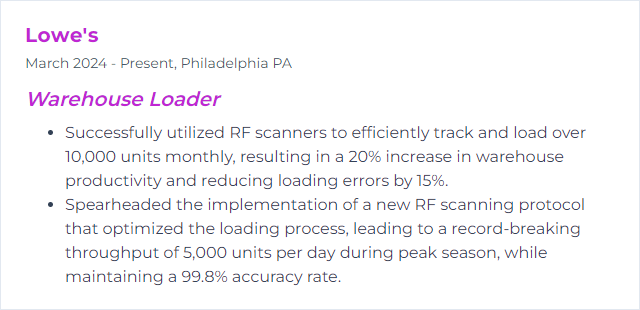
5. Order Picking
Order picking is selecting items from stock to fill a customer order—accuracy plus speed, under pressure.
Why It's Important
It’s the heartbeat of fulfillment. Hit rate and cycle time here ripple through the whole operation.
How to Improve Order Picking Skills
Zone Picking: Assign workers to defined areas to cut travel.
Batch/Wave Picking: Group similar orders to reduce passes through the same aisles.
Better Slotting: Put fast movers in golden zones near packout; right heights, right sides.
WMS Guidance: Use directed picks, optimized paths, and real‑time exceptions.
Pick Tech: Pick‑to‑light, voice picking, or mobile heads‑up prompts for fewer checks and faster confirmations.
Train and Tune: Short refreshers, pace coaching, and regular process tweaks based on KPI trends.
How to Display Order Picking Skills on Your Resume
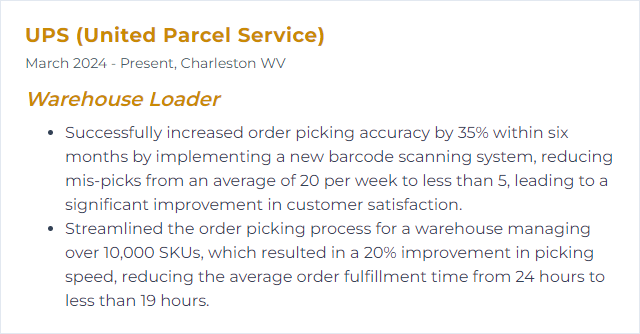
6. Shipping Procedures
Shipping procedures cover staging, documentation, checks, and safe loading so the right freight leaves on time and intact.
Why It's Important
Accurate, damage‑free shipments keep customers happy and costs predictable. Miss this, and everything wobbles.
How to Improve Shipping Procedures Skills
Real‑Time Visibility: Tie WMS to TMS or carrier tools so dock schedules and load statuses stay current.
Lean Flow: Reduce touchpoints, standardize work, and clear bottlenecks at the dock.
Safety First: Clear lanes, dock locks, chocks, and communication with drivers before a single pallet moves.
Quality Checks: Verify counts, labels, and packaging before seal—fix issues upstream, not at the gate.
Smart Packing: Use sturdy materials, right‑sized cartons, and dunnage that protects without wasting space.
Equipment Care: Keep liftgates, conveyors, and dock levelers on a maintenance cadence.
Clear Comms: Tight coordination between loaders, planners, and carriers when schedules shift.
How to Display Shipping Procedures Skills on Your Resume

7. Receiving Protocols
Receiving protocols standardize how goods are accepted, inspected, documented, and put away—fast, clean, correct.
Why It's Important
Good receiving kills errors early, protects product, and keeps inventory honest from day one.
How to Improve Receiving Protocols Skills
Standard Work: Define steps for unload, check, count, quality, and putaway with visual checklists.
Tech + Labels: Scan on receipt, use ASN data where possible, and follow GS1 label standards for consistency.
Training: Hands‑on practice for damage identification, exception handling, and accurate paperwork.
Quality Gates: Random audits and lot verification to spot drift and supplier issues early.
Feedback Loop: Capture bottlenecks and misroutes; adjust dock schedules, staffing, or slotting as needed.
How to Display Receiving Protocols Skills on Your Resume
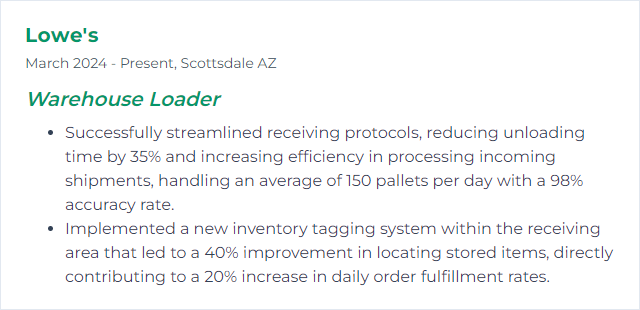
8. Warehouse Management Systems (WMS)
A WMS is software that directs receiving, putaway, picking, packing, and shipping—streamlining tasks and keeping data live.
Why It's Important
It keeps loaders in sync with the plan: fewer errors, better space use, and instant traceability.
How to Improve Warehouse Management Systems (WMS) Skills
Integration: Connect WMS with ERP, e‑commerce platforms, and carrier systems so orders and inventory match reality.
Real‑Time Data: Use live dashboards for inventory, dock status, and exceptions to make quicker calls.
Automation: Enable directed putaway, wave planning, cartonization, and rule‑based replenishment.
User Training: Short, role‑specific sessions; cheat sheets; sandbox practice for new features.
Continuous Improvement: Review KPIs, gather floor feedback, and tune configurations regularly.
How to Display Warehouse Management Systems (WMS) Skills on Your Resume

9. Safety Compliance
Safety compliance means following health and safety rules to cut risk and keep people—and product—out of harm’s way.
Why It's Important
It prevents injuries, protects the business, and sustains performance. Safe teams work better, longer.
How to Improve Safety Compliance Skills
Targeted Training: Job‑specific hazards, proper lifting, equipment use, spill response, and emergency drills.
Equipment Upkeep: Scheduled inspections and rapid repairs. Faulty gear gets tagged out, not “almost fine.”
Safety Culture: Encourage near‑miss reporting, daily huddles, and zero‑blame hazard escalation.
Audits and 5S: Regular walkthroughs, housekeeping standards, clear signage, and tidy aisles.
PPE: The right gear—gloves, eyewear, vests, toe protection—issued, worn, and replaced on time.
How to Display Safety Compliance Skills on Your Resume
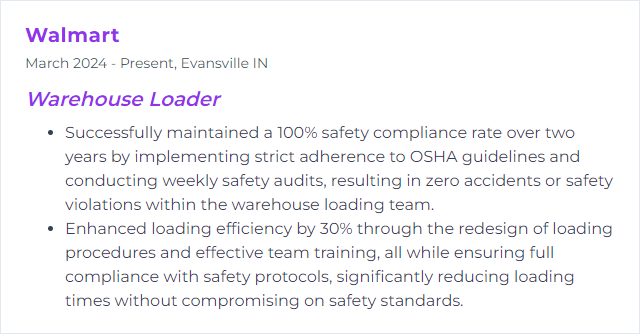
10. Barcode Scanning
Barcode scanning uses handheld or mounted readers to capture item data, keeping inventory moves precise and timely.
Why It's Important
Fast scans mean fewer data entry errors, quicker loading, and cleaner records—accuracy you can ship with.
How to Improve Barcode Scanning Skills
Capable Hardware: Rugged 1D/2D scanners that read at odd angles and handle worn labels.
Go Wireless: Cordless options for freer movement and fewer snags.
Label Placement: Put barcodes where they’re visible on pallets and cartons; follow GS1 sizing and contrast guidelines.
Training: Teach optimal scan distance and angle, plus quick troubleshooting.
Quality Checks: Verify print quality and reprint any weak labels before they cause rework.
Redundant Points: Scan at key handoffs—receive, move, pick, pack, ship—to catch discrepancies early.
Care and Calibration: Clean lenses, update firmware, and replace worn batteries before they fail.
How to Display Barcode Scanning Skills on Your Resume
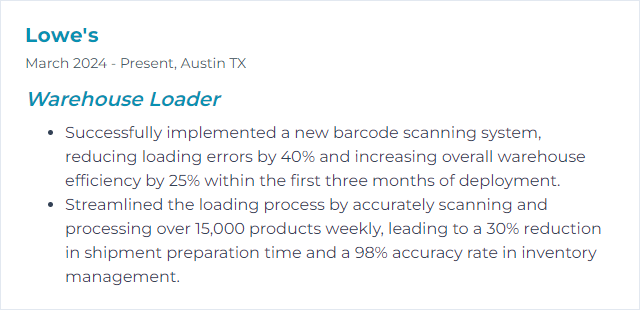
11. Packaging Standards
Packaging standards define how goods are protected, labeled, and prepared so they store well and survive the ride.
Why It's Important
Right pack, right label, right fit—less damage, faster handling, cleaner audits, and happier customers.
How to Improve Packaging Standards Skills
Know the Requirements: Match packaging to product fragility, weight, stack limits, and transit mode.
Right Materials: Use sturdy cartons, corner boards, straps, and stretch wrap that actually hold.
Efficient Design: Standardize sizes, cube out trailers, and avoid empty air.
Ongoing Training: Teach pack patterns, bracing, and labeling so every pallet looks intentionally built.
Quality Control: Spot‑check seals, labels, and stability before release.
Sustainability: Reduce waste, pick recyclable materials, and right‑size to cut dunnage.
Tools and Automation: Stretch‑wrap machines, carton sealers, and print‑and‑apply labels to keep pace and consistency.
How to Display Packaging Standards Skills on Your Resume
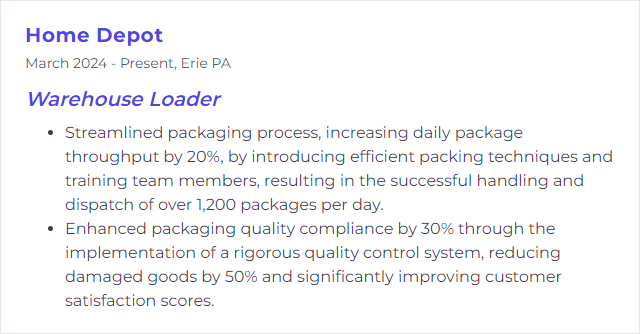
12. Material Handling Equipment
Material Handling Equipment (MHE) covers forklifts, pallet jacks, conveyors, carts, and automated systems that move, protect, and store goods.
Why It's Important
MHE multiplies muscle. It speeds flow, reduces injuries, and protects inventory—when chosen and cared for well.
How to Improve Material Handling Equipment Skills
Regular Maintenance: Inspections, lubrication, parts replacement, and battery care on a set cadence.
Operator Training: Technique, safety checks, and emergency procedures tailored to each equipment type.
Upgrade Thoughtfully: Newer models often bring better ergonomics, visibility, and energy efficiency.
Automate Where It Pays: Conveyors, AGVs/AMRs, or robotic assist for repetitive hauls and long runs.
Ergonomics: Adjustable controls, low‑effort starts, and designs that cut strain during long shifts.
Layout Matters: Plan clear travel paths, staging zones, and charging areas to avoid traffic jams.
Review and Improve: Track utilization and downtime; gather operator feedback and act on it.
How to Display Material Handling Equipment Skills on Your Resume

